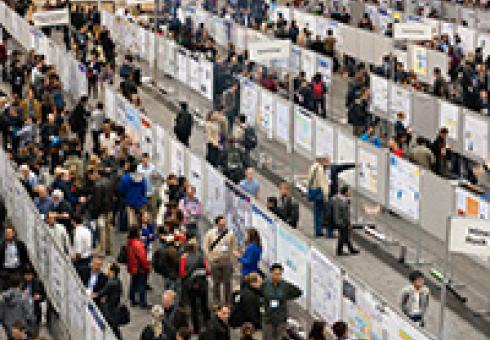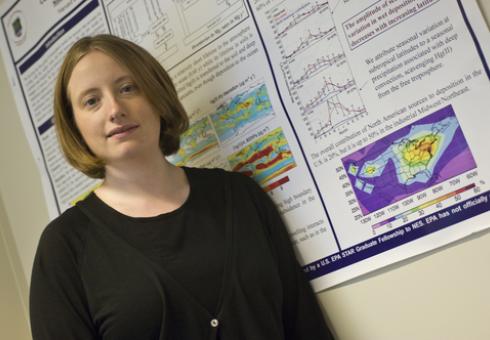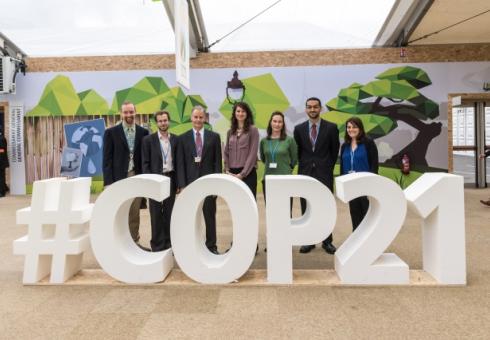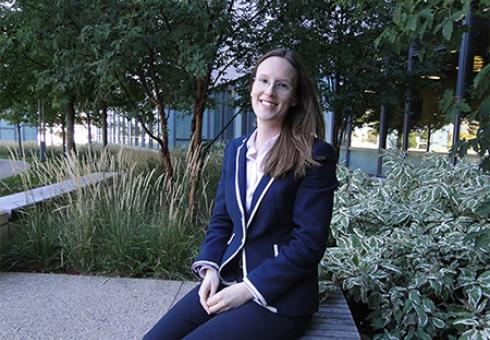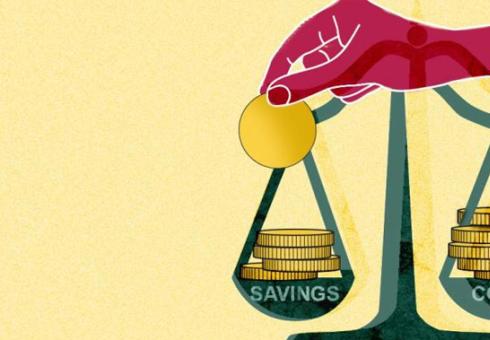News and Outreach: Noelle Selin
Benefits from international regulations may double those of domestic policy
MIT events throughout climate talks underscore Institute's global perspectives and partnerships
New findings show Asia produces twice as much mercury emissions as previously thought.
Jennifer Chu | MIT News Office
Once mercury is emitted into the atmosphere from the smokestacks of power plants, the pollutant has a complicated trajectory; even after it settles onto land and sinks into oceans, mercury can be re-emitted back into the atmosphere repeatedly. This so-called “grasshopper effect” keeps the highly toxic substance circulating as “legacy emissions” that, combined with new smokestack emissions, can extend the environmental effects of mercury for decades.
Now an international team led by MIT researchers has conducted a new analysis that provides more accurate estimates of sources of mercury emissions around the world. The analysis pairs measured air concentrations of mercury with a global simulation to calculate the fraction of mercury that is either re-emitted or that originates from power plants and other anthropogenic activities. The result of this work, researchers say, could improve estimates of mercury pollution, and help refine pollution-control strategies around the world.
The new analysis shows that Asia now releases a surprisingly large amount of anthropogenic mercury. While its increased burning of coal was known to exacerbate mercury emissions and air pollution, the MIT team estimates that Asia produces more than double the mercury emissions previously estimated.
Noelle Selin, the Esther and Harold E. Edgerton Career Development Associate Professor in MIT’s Institute for Data, Systems, and Society and the Department of Earth, Atmospheric and Planetary Sciences, says the new analysis can also give scientists a better idea of how long legacy emissions — mercury re-emitted by the land and ocean — stick around in the atmosphere. This is because the analysis can more accurately calculate the total amount emitted by land and ocean sources.
“The timescale under which mercury circulates in the environment tells us about how fast we’ll recover if we limit mercury emissions,” Selin says. “We can better quantify mercury cycling with this method.”
Selin and Shaojie Song, a graduate student in EAPS, have published their results in the journal Atmospheric Chemistry and Physics.
Top-down approach
The team’s analysis improves on other models that take a bottom-up approach. Such models estimate mercury emissions for a region by considering factors such as the amount of coal burned in a power plant and the types of equipment in a plant used to control emissions. Models then often extrapolate data from a few sources to apply to an entire region.
However, there are a number of uncertainties with such bottom-up modeling, and it’s often difficult to obtain the required data from individual power plants.
Instead, Selin and Song’s analysis takes a top-down approach, combining bottom-up estimates with actual measurements of mercury emissions from monitoring stations around the world.
In their analysis, the team took bottom-up estimates of mercury emissions from a 2010 emissions inventory by the United Nations — a frequently used source of estimated anthropogenic emissions around the world. The researchers plugged these emissions into a global mercury transport model called GEOS-Chem — a model originally developed by Selin that has since been used widely to track how mercury circulates through the land, ocean, and air.
The GEOS-Chem model essentially divides the atmosphere into many small boxes. After plugging in bottom-up estimates of mercury emissions, the researchers ran the model to simulate the chemical and physical processes that act to circulate mercury within and between boxes. They then obtained actual measurements of mercury emissions taken from monitoring stations around the world. They compared each station’s measurements with the model’s estimates for the corresponding box in which the station was located.
“We can definitely see some differences, which tells us the [bottom-up] emissions may be wrong in some places,” Song says.
Assessing policy levers to address mercury
For locations where the measured and modeled emissions did not match up, the group used a Bayesian inversion method — a mathematical probability theory that combines observations with prior knowledge to model uncertainty. With this method, Selin and Song determined, for each station’s location, the quantitative contribution of mercury sources that would make up the total measured concentrations. For example, a location in the middle of the ocean, far from any terrestrial sources, is more likely to see mercury emissions that are re-emitted from the ocean, rather than from terrestrial or anthropogenic sources. Then, in a first application of these techniques to global mercury concentrations, they used this quantitative approach to calculate what measured concentrations implied about their sources.
By their calculations, the researchers estimated that, worldwide, Asia could produce up to 1,770 tons of mercury emissions per year — more than twice the amount estimated by bottom-up models.
“It was higher than we expected,” Selin says. “Given the pollution in China and India and increased use of coal, it does make sense. It wasn’t an out-of-the-ballpark result, but it does give you some pause to think about how much mercury could be coming out of Asia.”
In related work published this spring, Selin’s research group assessed how a new U.N. treaty could affect future mercury emissions from coal-fired power plants in Asia. They concluded that future emissions controls would have both global and domestic benefits.
In their more recent top-down analysis, the team also found that fewer mercury emissions came from terrestrial sources, meaning the land re-emitted a smaller amount of legacy emissions than expected — a small silver lining in a world of continuing mercury pollution, according to Selin.
“That means that legacy mercury is a smaller fraction of present-day mercury emissions than we thought, which means that the policy lever for addressing mercury pollution through controlling current emissions is slightly larger,” Selin says. “You still have to worry a lot about legacy emissions, but we could recover a bit more quickly because they are a smaller fraction of the total.”
This research was funded, in part, by the National Science Foundation.
Grants of up to $200,000 will fund environmental partnerships over the next two years
 |
||
|
|
Photo: Christopher Harting |
by Jennifer Chu | MIT News Office
Joint Program researchers Prof. Valerie Karplus and Prof. Noelle Selin receive grants from from the Environmental Solutions Initiative to examine how current efforts to reduce coal use in China affect toxic air pollution across Asia.
How can sustainable consumption in U.S. cities be fostered? Can the ocean floor be mined in an ecologically benign way? What are the health risks associated with the mining of rare metals used in energy-efficient products like photovoltaic devices? And how can truly promising environmental solutions have a better chance of becoming real economic policies?
These are some of the complex questions that researchers at MIT will now be able to tackle, with support from the MIT Environmental Solutions Initiative (ESI). The initiative was established last May to inspire solutions to major environmental problems through collaborative partnership.
In response to a call for research proposals, the ESI received 59 submissions. In March, the initiative awarded seed grants of up to $200,000 to nine research groups over the next two years.
ESI director Susan Solomon, the Ellen Swallow Richards Professor in MIT’s Department of Earth, Atmospheric and Planetary Sciences, says the seed grants have jumpstarted new collaborations among a variety of disciplines across campus.
“I was really pleased that so many people reached out to colleagues and looked at new collaborations, which was exactly what we were hoping would occur as a result of this process,” Solomon says. “There’s a lot of new thinking here. … I’m really pleased that people began those conversations. I think they’re just going to continue to grow and blossom as this initiative moves forward.”
The nine winning proposals fell into four main themes: sustainability; metals and mining; healthy cities; and climate/risk/mitigation.
Sustainability
According to the Environmental Protection Agency, humans have consumed more material and natural resources in the past 50 years than in the entire previous history of human existence. To curb consumption, the environmental community has encouraged the practice of sustainable consumption, using the mantra: “Reduce, Reuse, Recycle.”
But how are U.S. cities — hubs of materialism and consumption — actually practicing sustainable consumption? A group of urban planners, architects, and historians led by Judith Layzer, a professor of environmental policy in the Department of Urban Studies and Planning, will carry out a survey of 285 municipalities to explore the degree to which sustainable consumption goals have been adopted by local governments. The group wrote in its proposal that it hopes the survey will serve as a “valuable resource for cities that aspire to move toward sustainable consumption.”
Finding solutions to major environmental problems often involves input from both technology and policy experts — but it can be frustrating for both parties when they find that reasonable solutions can be difficult to put into practice. A classic example is the shared resource, such as a groundwater aquifer, that is overused to the point where it fails to benefit all parties. A group of engineers and economists, led by Dennis McLaughlin, the H.M. King Bhumibol Professor in the Department of Civil and Environmental Engineering, and Parag Pathak, an associate professor of economics, will examine the behaviors that drive competition for natural resources using game theory, a framework that has been used to analyze cooperative behavior in economics.
“There is a gap between the promise of game theory and the continuing difficulty of designing workable policy solutions to environmental issues,” the team wrote in its grant proposal. “The ESI seed grant program gives us a chance to narrow these gaps, so that the environmental solutions we propose as a community have a better chance of being implemented as real policies.”
Metals and mining
Metals and mining products are increasingly used to support development. For example, they are essential to building wind turbines, solar panels, photovoltaic devices, and lithium-ion batteries.
But as societies depend more on rare metals for products, what impact will rising demand have on the environment? A group of engineers, led by Antoine Allanore, the Thomas B. King Assistant Professor in Metallurgy, and Alan Hatton, the Ralph Landau Professor of Chemical Engineering Practice, plans to launch a metals and mining initiative at MIT. As part of the project, the team will organize several symposia on campus that will connect industry stakeholders with MIT researchers to explore issues of sustainable mining.
Rare metals like indium and lanthanide are increasingly mined for use in high-efficiency photovoltaic devices, light-emitting diodes (LEDs), and batteries for hybrid cars. The effects of these metals on the environment and human health are unknown. A team of engineers led by John Essigmann, the William R. and Betsy P. Leitch Professor in the Department of Biological Engineering; Bevin Engelward, a professor of biological engineering; and Harold Hemond, the William E. Leonhard Professor in the Department of Civil and Environmental Engineering, will combine techniques in geochemistry and cell and molecular toxicology to assess the adverse effects of rare metals in the environment, and their potential impact on human health. Such an assessment, the team wrote in its proposal, should occur before new substances are introduced widely in the environment: “History provides numerous cautionary examples of the great economic and societal costs incurred when knowledge lags behind the deployment of new products.”
Deep below the ocean floor, there exist vast resources of gold, copper, platinum, and other rare metals — resources that are increasingly in demand for use in electronics and energy-efficient products. The world’s first deep-sea mining operation, scheduled to commence in 2017, will dig beneath the Bismarck Sea, off Papua New Guinea, for minerals. But scientists are concerned that mining operations may create currents that carry pollutants up from the deep sea, potentially poisoning marine species and the humans that consume them.
A team led by Thomas Peacock and Pierre Lermusiaux, both associate professors of mechanical engineering, and Glenn Flierl, a professor of oceanography, will develop a detailed ocean model to identify key circulation patterns in the region and determine the biological impacts of the mining operations. The team says the modeling tools developed through this effort “can be applied to any proposed location for the growing field of deep-sea mining.”
Healthy cities
China has some of the world’s worst air pollution, as well as half its mercury emissions, due to its rising use of coal. In the last few years, the country has adopted policies to curb coal use and reduce air pollution. It is unclear, however, whether these measures will be consistent with the air-quality improvements set by newer policies.
A team of economists, engineers, and atmospheric chemists led by Valerie Karplus, an assistant professor of global economics and management, and Noelle Selin, the Esther and Harold E. Edgerton Assistant Professor in the Engineering Systems Division and the Department of Earth, Atmospheric and Planetary Sciences, will examine how current efforts to reduce coal use in China affect toxic air pollution across Asia. The team will also estimate changes in coal demand throughout Asia, as China’s own demand for coal falls. The team’s proposal states: “Our systems approach enables us to fully evaluate and identify effective efforts to address regional air quality, taking into account both the complexity of economic interactions and atmospheric chemical behavior.”
Detailed measurements of air quality, particularly in urban environments, will ultimately help to reduce populations’ exposure to air pollutants. In recent years, advances in sensor technology have offered the promise of sensitive, distributed, urban air-quality networks, although few actually exist. A group of urban planners, atmospheric chemists, and civil engineers plans to address the need for air-quality networks, using “big data.” The team plans to examine air-quality measurements around the MIT campus and in Beijing, and apply advanced data-analysis techniques to gain “quantitative insight” into pollution sources.
This project, the team says, “would represent the first application of machine-learning tools to environmental sensors.” The work will be led by Marta Gonzalez, an assistant professor of civil and environmental engineering; Colette Heald, the Mitsui Career Development Associate Professor in Contemporary Technology; Jesse Kroll, an associate professor of civil and environmental engineering, and Jinhua Zhao, the Edward H. and Joyce Linde Professor in the Department of Urban Studies and Planning.
Climate/risk/mitigation
Tropical peatlands, swamp forests found mostly in Southeast Asia, are thought to be vast carbon sinks, containing up to 70 billion tons of carbon — about 3 percent of the world’s soil carbon. Over the last 25 years, peatland forests have been cut and drained so that the underlying peat acts not as a sink, but a source, emitting enormous stores of carbon dioxide and methane into the atmosphere.
Policymakers and researchers suggest that controlling these emissions would be a cost-effective way to reduce the world’s total greenhouse-gas emissions. But there’s little knowledge about the physical and biological processes within peatlands that control carbon and methane fluxes. A group of engineers and atmospheric scientists will study soil processes in Brunei, on the island of Borneo, to characterize the flow of carbon dioxide and methane to the atmosphere. The researchers ultimately hope to apply their results to strategies for controlling greenhouse gas emissions. The group includes Charles Harvey, Benjamin Kocar, and Martin Polz of the Department of Civil and Environmental Engineering and Shuhei Ono and Roger Summons of the Department of Earth, Atmospheric and Planetary Sciences.
While two-thirds of greenhouse-gas-induced warming is due to carbon dioxide, other gases, such as methane and halogen-containing gases, contribute significantly to climate change. In the near future, these emissions may increase as a fraction of total greenhouse-gas emissions, as policies to reduce carbon dioxide bear results. As countries transition from coal to natural gas for electricity, more methane may escape into the atmosphere through leaks in natural-gas pipelines.
A team led by Jessika Trancik, the Atlantic Richfield Career Development Assistant Professor in Energy Studies, and Francis O’Sullivan, director of research and analytics at the MIT Energy Initiative, will develop metrics to compare climate impacts of non-carbon dioxide emissions, such as methane. The researchers will use the metrics to identify ways to reduce these emissions, particularly those of methane through the natural-gas supply chain. The team will use these results to inform current U.S. policy, including a new federal initiative to reduce methane. “Climate change mitigation is a multi-gas problem,” the researchers wrote in their grant proposal. “This work will inform important policy decisions that are slated to be made in the next few years.”
MIT's Prof. Noelle Selin appeared on CBC's The Exchange with Amanda Lang to discuss the findings of a study recently published in Nature Climate Change. Watch the interview below.
The Atlantic reports on an MIT study that concludes that cost of limiting carbon emissions would pay for itself in human health benefits.
"
James Hamblin
The Atlantic
The polar ice caps feel remote. The threat of orioles permanently leaving Baltimore for cooler climates might be a little more compelling. But researchers are learning that the most effective way around climate-policy ambivalence is to invoke imminent dangers to human health. "What's killing me today?" with emphasis on killing and me and today.
For one, when there is more carbon dioxide in the environment, plants produce more pollen, which is no good for allergies and asthma. Rutgers allergist Leonard Bielory recently warned that pollen counts are projected to double by 2040. Likewise, U.S. foresters recently calculated that trees seem to be averting around $6.8 billion in human health costs annually, largely due to mitigating effects of air pollution (even if they do produce pollen). And already the World Health Organization is warning that air pollution is responsible for one out of every eight human deaths, largely because combustion of fossil fuels results in invisible airborne particles that get lodged in our lungs and suspended in our blood.
But is that worth the cost of implementing policies that limit carbon emissions? Some say yes.
Yesterday researchers released findings that say an economy-wide cap on carbon emissions stands to pay for itself about 10 times over in near-term human medical benefits, specifically reductions in costs associated with respiratory diseases, like asthma, and premature death. A standard, economy-wide cap and trade program, the MIT-based research team found, would result in a net benefit of $125 billion in human health costs. The work is published in the journal Nature Climate Change.
“We were looking at ozone and particulate matter, the two biggest air quality issues in the United States,” Tammy Thompson, a research scientist at Colorado State University with the Cooperative Institute for Research in the Environment, told me.
The Christian Science Monitor writes about an MIT climate change study released Sunday, indicating that the cost of slashing coal-fired carbon emissions would be offset by reduced spending on public health. The EPA-funded study examined climate change policies similar to those proposed by the Obama administration in June.
Jared Gilmour
Christian Science Monitor
President Obama’s controversial plan to phase out coal and slash carbon emissions is an expensive one. But a new study suggests it could be cheaper than the alternative: pollution, poor air quality, and accompanying health costs.
Cutting emissions might lower health spending so drastically that the US could end up saving ten times more than it would cost to implement carbon reductions, according to a Massachusetts Institute of Technology study published Sunday in the journal Nature Climate Change.
Environmentalists have long argued that curbing pollution is good for protecting local habitats and public health. Recently, though, the push for tighter environmental protections has sometimes shifted the focus from human health and conservation to climate change. The MIT study ties both environmental paradigms together, demonstrating how policies targeting carbon emissions can boost public health by reducing the more conventional pollutants emitted alongside greenhouse gases. Those conventional pollutants include particulate matter and carbon monoxide, which officials link to increased incidence and severity of illnesses like asthma, heart disease, and lung cancer.

